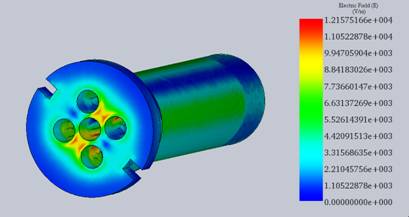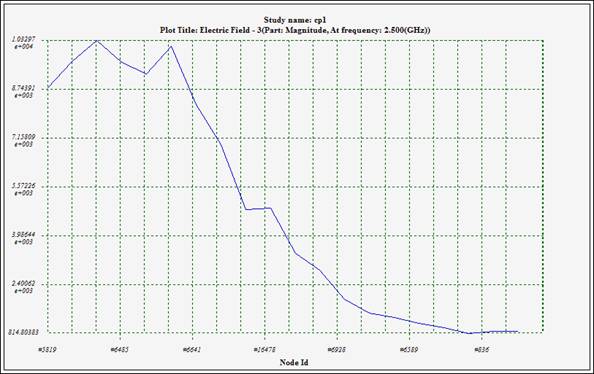A Quadrax Connector for 100 Mbps Ethernet Operation
A Quadrax
The Quadrax connector, produced by Souriau-Corporation, is a high-performance, four-channel differential connector optimized for high-speed electrical networks. It boasts outstanding network capabilities, minimal crosstalk, and precise matching, making it ideal for use in challenging environments and dense link configurations. This brief outlines the process of simulating a 100 Mbps Ethernet Quadrax contact at 2.5 GHz using HFWorks for S-Parameter analysis, highlighting its robustness and suitability for demanding applications.

Figure 1 - Quadrax 3D view
Simulation
This simulation aims to analyze the frequency responses—insertion and return losses—of the device using S-Parameter simulation. With a detailed frequency range from 100 MHz to 2.5 GHz, it enables observing wave propagation within the quadrax and measuring field intensity along specific curves or shapes, ensuring precise evaluation of the device's performance across a broad spectrum.
Load/ Restraint
The quadrax connector features two ports positioned on its lateral sides to support TEM mode propagation. It incorporates four signal boundary conditions with a perfect electric conductor on the quadrax's outer surface, ensuring efficient transmission paths.
Results
At the user-defined center-frequency, one can visualize the electric and magnetic fields in various settings, such as iso and section clipping, with the option to animate changes through omega-T phase adjustments and use a modified color chart. This allows for a detailed examination of the electric field distribution on the quadrax's outer surface, enhancing understanding of its electromagnetic behavior.

Figure 2 - Near field distribution
The iso or section clipping feature allows for the inspection of the field's inner distribution within the quadrax, offering a nuanced view of how the fields behave internally. This tool is particularly useful for a deeper understanding of the electromagnetic properties and the efficiency of the design in guiding signal propagation.

Figure 3 - Inner Electric field distribution

(1).png)
Figure 4 - Insertion/ Return loss
The return and insertion losses of the quadrax meet manufacturer expectations, showcasing its efficiency. Further analysis is possible by probing specific points on a 3D electric field plot, revealing electric field variations from the central axis to the lateral face. The analysis uses ordinal numbers of the nodes in the created mesh for detailed examination.

Conclusion
This application note presents a comprehensive simulation of a Quadrax connector, a high-performance, four-channel differential connector designed by Souriau-Corporation for high-speed electrical networks. Optimized for 100 Mbps Ethernet operations at 2.5 GHz, the connector demonstrates superior capabilities in minimizing crosstalk and ensuring precise matching, making it exceptionally suitable for demanding environments and dense link configurations. Utilizing HFWorks for S-Parameter analysis, the simulation covers a detailed frequency range from 100 MHz to 2.5 GHz, allowing for an in-depth assessment of frequency responses, including insertion and return losses. Key features include TEM mode propagation supported by two ports with perfect electric conductor boundary conditions for effective signal transmission. The results, highlighted by visualizations of electric and magnetic fields, affirm the Quadrax connector's robustness and high efficiency in guiding signal propagation, meeting the stringent expectations for high-speed network applications. This analysis underscores the Quadrax connector's reliability and performance, solidifying its position as a critical component in advanced electrical systems.





